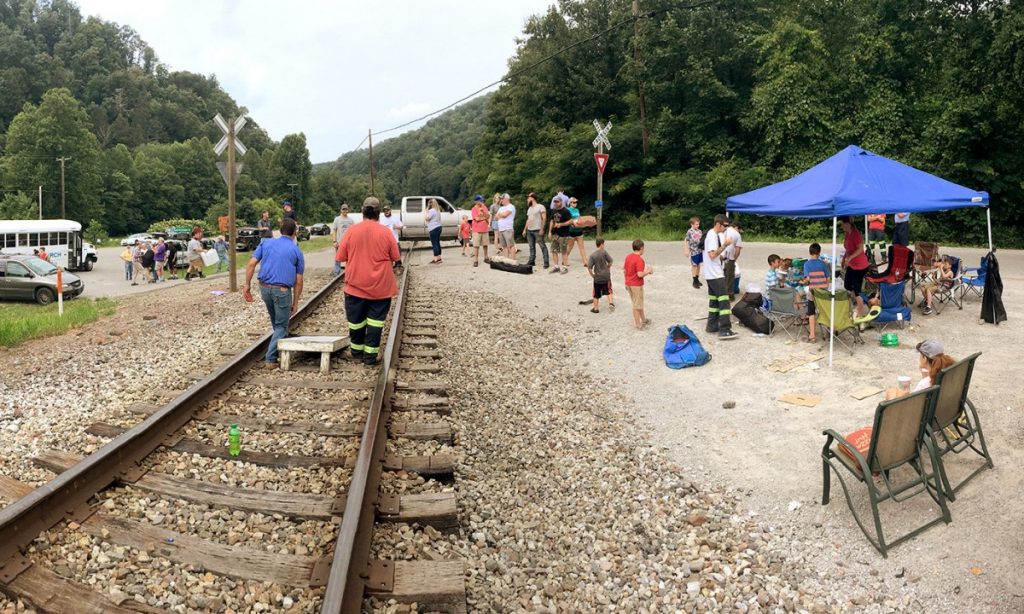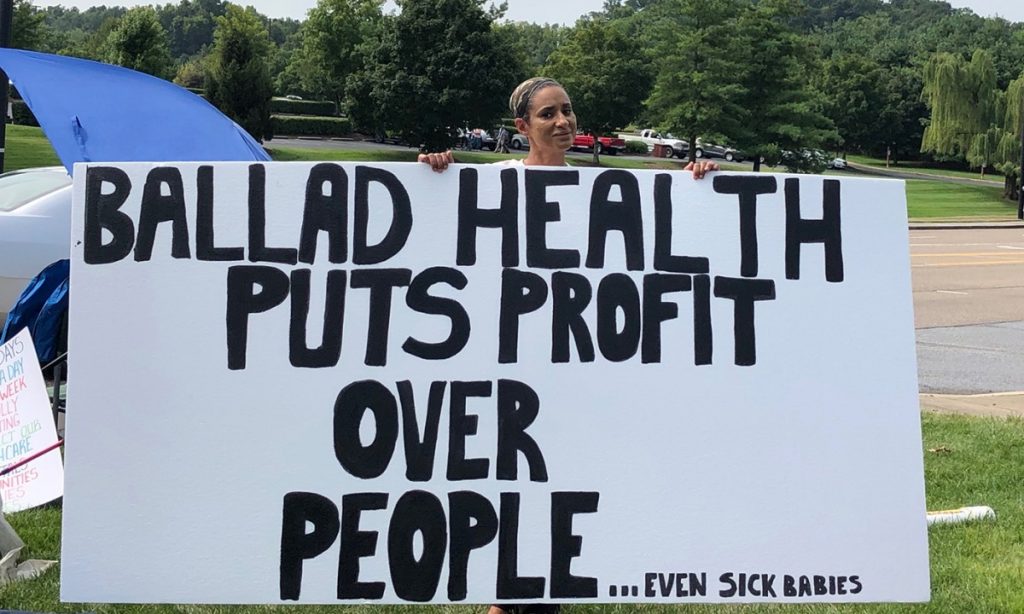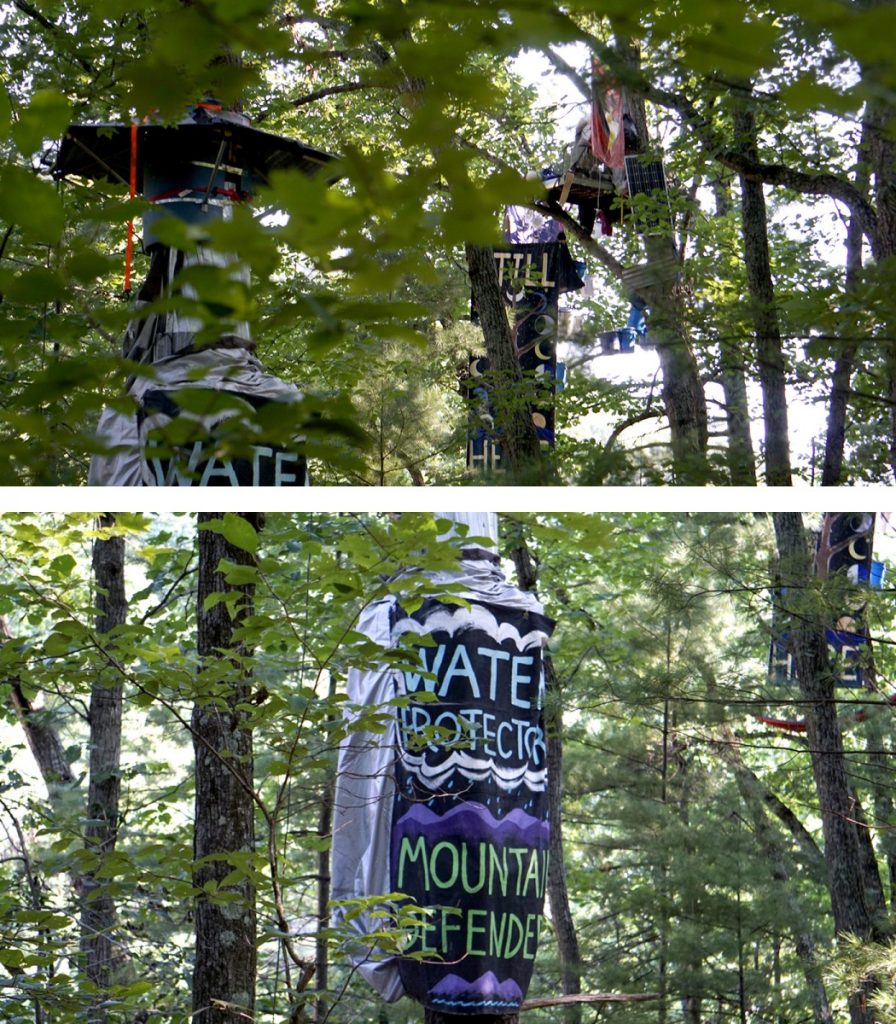Protest runs through the region’s veins like coal seams through the mountains.
When a group of Kentucky miners decided to block a coal-laden train from leaving a bankrupt mine in July, they weren’t just laying claim to missing paychecks.
The miners in Harlan County won attention across the United States for their willingness to put their bodies on the line for their beliefs. In doing so, they’re invoking the long-entrenched spirit of civil disobedience and direct action in the Appalachian Mountains. The mine wars of the early 20th century led to the rise of American unions in the 1930s and 1940s, but it’s not just coal miners who have laid claim to a history of activism.
The first day of the Harlan County train blockade, July 29, 2019, also marked the 89th day of a 24/7 protest in Kingsport, Tennessee, over a monopolistic health care provider’s move to downgrade a hospital’s emergency services and close its neonatal intensive care unit, where sick newborns are treated.
And July 29 was the 328th day of the Yellow Finch Lane tree-sits in Montgomery County, Virginia, where two anonymous tree-sitters and a small support camp block construction of a 303-mile, 42-inch wide pipeline being built to move natural gas from the fracking fields of the Marcellus and Utica shale formations in northern West Virginia to a terminal just north of Danville in southern Virginia. From there, the gas would be sent on to the East Coast, and perhaps overseas.
These ongoing actions aren’t recent aberrations. In 2018, more than 20,000 teachers in all of West Virginia’s 55 counties went on strike for two weeks to secure better pay and benefits—and in the end were successful. That action inspired similar teacher strikes in Kentucky, Oklahoma and elsewhere.
In the mid-’00s, activists trying to stop mountaintop removal coal mining—a form of surface mining that uses explosives to blow off ridge tops to expose underground coal seams—regularly took part in direct actions, chaining themselves to equipment, disrupting stockholder meetings, and blocking access to mine sites and facilities.
These activists run the gamut in terms of age, class, race, ethnicity and hometowns. Women tend to be more prevalent in these actions than men, but everyone shares the frustration of fighting against a system that feels rigged, where other options are blocked, and the only thing left to do is to fight using one’s body.
New generations join the fight for their rights
The depth of Appalachia’s activist tradition can be seen in Becky Crabtree of Lindside, West Virginia. Crabtree grew up near Bluefield and went to work as a teacher in McDowell County in 1975. The year she started, local teachers, including her mother, went on strike for better pay, but Crabtree was afraid of losing her new job.
“When I didn’t sign to go out on strike, teachers I loved and respected circled my car and asked why I wasn’t going to go out on strike,” Crabtree said. “It was my first grown-up job, and I told them I had agreed to work. They explained to me I had to go out on strike, and I understood. We stood together and had to go out on strike.”
The teachers struck again in 1986, and Crabtree, now with 11 years of experience, became much more involved. By 2018, she was a substitute teacher, and she didn’t go to Charleston to rally with thousands of others at the State Capitol, but she watched the children of those who did. She also took to the streets with signs of support for the striking teachers, standing with her mother and her daughters—three generations of West Virginia teachers—encouraging car drivers to honk their support.

That summer, Crabtree also protested construction of the Mountain Valley Pipeline across her Monroe County sheep farm by chaining herself to her 1971 Ford Pinto—the same car the other teachers surrounded in 1975—which was placed on concrete blocks straddling the pipeline trench.
“I had done all the things I knew to work the system,” Crabtree said. “I had been to town meetings. I had spoken at pipeline-sponsored gatherings. I spoke about it on TV. We collected petitions. We had a case lined up to go to the U.S. Supreme Court about eminent domain, but they chose not to hear it this year. We had done everything we knew to do. It was all I could do, was to put my body across the pipeline.”
Ultimately, Crabtree said she disrupted about a half-day’s worth of work by pipeline crews before she was arrested and removed from the Pinto. She was charged with obstruction, but the charge was eventually dismissed.
Taking a stand—or a sit—against fossil fuels
Crabtree’s action marked just one episode in a substantial campaign against the Mountain Valley Pipeline. Tree-sitters placed their bodies in the way of pipeline construction in Monroe County, West Virginia, and Franklin, Giles, Montgomery and Roanoke counties in Virginia. The longest-running tree-sit is near the town of Elliston on Yellow Finch Lane, where, as of September 2019, tree-sitters and a support camp have been in place for more than a year.
On the day the Harlan County miners began their train blockade, the Yellow Finch tree-sit was preparing for the possible arrival of federal marshals, because the pipeline company had asked a judge to remove them. That morning, a bulldozer roared on the opposite slope of the narrow hollow as protesters made breakfast and talked about what might happen later. The judge ultimately declined to remove the protesters, who remain in the trees to buy time while other activists pursued legal and regulatory avenues to halt construction.

The anti-pipeline movement grew largely from organizing efforts that were developed more than a decade ago to fight mountaintop removal in central Appalachia. Erin McKelvy, who works with the group Appalachians Against Pipelines, grew up outside Blacksburg, Virginia, and took part in Take Back the Night rallies with her mother, a professor at Virginia Tech.
McKelvy found another mentor in Sue Daniels, a local mountaintop removal activist who took her along on a 2004 trip to Inman, Virginia, where a 3-year-old boy had been killed in his sleep by a flying boulder blasted from a nearby surface mine. The two joined with others to plan what became known as 2005’s Mountain Justice Summer and the beginning of a protracted campaign against coal companies.
The training sponsored by Mountain Justice taught McKelvy about direct action, preparing for legal fallout, speaking to media, and the importance of centering local leaders and voices.
Direct action, McKelvy said, “is a necessary tool in the toolbox. When regulatory agencies say yes to things that are in clear violation of the charters they have to protect air, water and the environment, and when there’s so much momentum behind the sort of toxic death culture status quo, sometimes it takes physically getting in the way of those things that are destructive and dangerous to actually get anywhere.”
Making business work for communities
Numerous Yellow Finch tree-sitters cited the Dakota Access Pipeline protests of 2016 and 2017 at Standing Rock Indian Reservation as a galvanizing moment for them. That event also has inspired other actions, including an around-the-clock protest at a hospital in Kingsport, Tennessee, that as of September 2019 stretched beyond 140 days.
Dani Cook grew up in Bristol, which straddles the Tennessee-Virginia line, but was living in Charlotte, North Carolina, when she traveled to Standing Rock and spent five days with a group of military veterans supporting the protest. The experience left a lasting impression, so when Cook learned that the neonatal intensive care unit at Holston Valley Medical Center was scheduled to close as part of the hospital being downgraded as a trauma center, she took to the street.
“When I came out here, I was by myself,” Cook said. “I had no clue if anyone would come with me. All I knew is that what’s happening here is so wrong, we just have to do something. At first, I thought that was emails and phone calls. I thought it was 450 people showing up at the [public] hearing. I thought, surely when the state hears from nurses and doctors and the community, it will do something. When that didn’t work, all I knew to do was to make it physical.”

Cook stationed herself on the sidewalk in front of the hospital and started talking about the plan set in motion by the hospital’s owner, Ballad Health. Before long, she was joined by other people, and since then they’ve been a constant presence on the road in front of Holston Valley, waving signs, asking motorists to sign petitions and waving to honking cars.
“Our protest is 90 percent women,” Cook said. “We have probably eight or so men who are here. Right now, it’s four of us women and one man out here. That’s pretty much the norm.”
Women take the lead throughout history
That dynamic—of women taking leadership roles and driving direct action—appears throughout Appalachia, both geographically and throughout history.
“Women putting their bodies on the line—because that is really what they’re doing— has been a historical pattern,” said Jessie Wilkerson, a professor at the University of Mississippi and author of To Live Here, You Have to Fight: How Women Led Appalachian Movements for Social Justice. “They always center what I and other scholars call ‘caring labor.’ They’re really emphasizing the labor that it takes to sustain life, to take care of other people, to take care of children, to take care of the environment, to take care of their communities.”
Wilkerson’s book was inspired by the Brookside Women’s Club of Harlan County, Kentucky, which played a pivotal role in the ’70s strike whose memory has been stoked by the train blockade. That’s just one example of women taking the lead in direct action.
Ollie “Widow” Combs, for example, placed her body before a bulldozer at a strip mine above her Kentucky home in 1965, leading to her arrest and inspiring future movements such as Mountain Justice, 40 years later.
Kentucky residents also picketed over potential hospital closures in Hazard, Harlan, Middlesboro, and Whitesburg in the early ’60s. Those protests eventually resulted in the establishment of numerous community-based clinics as part of Presidents John Kennedy and Lyndon Johnson’s “War on Poverty” programs.
“Often the story is told as the federal government swoops in and is telling people what to do, but in fact, this came from protests around Washington, D.C., and in the region because of the hospital closures,” Wilkerson said.
That action has echoes today in the Holston Valley protests.

Wilma Lee Steele, a resident of Matewan and a board member for the West Virginia Mine Wars Museum, fought coal and gas companies as a landowner whose property was dramatically affected by both. She said that today’s activists increasingly connect their fights with the labor actions found throughout Appalachia’s history, such as the West Virginia mine wars, an escalating series of labor showdowns that culminated in a 1921 declaration of martial law when thousands of miners faced off against law enforcement and private detectives on Blair Mountain. That vibrant connection between the past and present, Steele said, is a good thing.
“There’s things happening in West Virginia,” Steele said. “You see communities doing something. It can be hard to see, but underneath is a wave.”
Crabtree, the teacher whose car was surrounded by striking teachers in 1975, remembered what she felt as she sat chained to that same car 43 years later, waiting in the early morning mists for pipeline crews to arrive.
“There’s nobody in sight,” she said. “Just the shadows of the trees. It’s not quite daylight but it’s not dark. It was one of the most peaceful moments of my life. That’s real important to me. There was absolutely no fear. I knew logically that no jury in Monroe County would convict me of a crime for sitting on my own land, and I was doing the right thing. It’s a wonderful feeling, of doing the right thing.”
This article was funded in part by a grant from the One Foundation. It was originally published by YES! Magazine.



